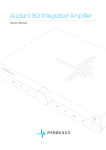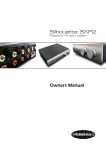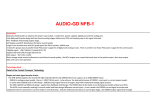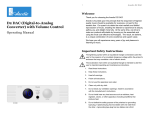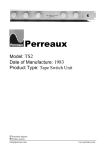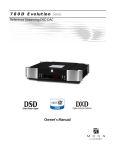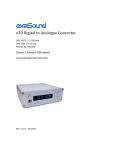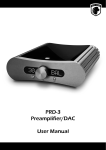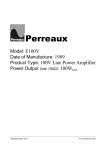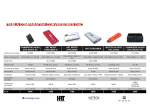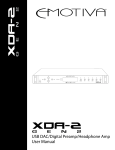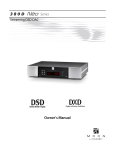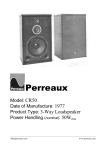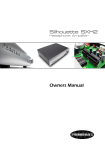Download Manual for Audiant DP32
Transcript
Audiant DP32 DAC Preamplifier Owners Manual Important Safety Instructions Explanation of symbols used in this manual or on the rear of the device: This symbol is intended to alert the user to the presence of uninsulated dangerous voltages within the enclosure of sufficient magnitude to cause electric shock. This symbol is intended to alert the user to the presence of important operation, maintenance and servicing information in the instruction and service manuals. Caution • • • • • To reduce the risk of electric shock, do not remove the cover. No user serviceable parts inside. Refer servicing to qualified service personnel. Replace the mains fuse in the plug with one of the same type and rating. Disconnect supply cord before changing fuse. Warning To reduce the risk of fire or electric shock, do not expose this device to rain or moisture. Shock hazard - do not open. Mains Plugs • • 1 • • • • • This device is supplied with a non-rewireable mains plug for the intended country. Replacement mains leads can be obtained from your Perreaux dealer. Should you need to change the plug please dispose of it carefully. A plug with bared conductors is dangerous if engaged in a live socket. The Brown wire must be connected to the Live (Line) supply pin. The Blue wire must be connected to the Neutral supply pin. The Green/Yellow wire must be connected to the Earth (Ground) supply pin. Please contact your dealer or a competent electrician if you are in any doubt. Refer to the rear of the product for fuse and mains voltage information. This product is designed to comply with international directives on the Restriction of Hazardous Substances (RoHS) in electronic equipment. The wheelie bin logo indicates compliance and that these products must be recycled or processed as according to these directives. General Safety Instructions All safety and operation instructions should be read carefully before the DP32 is operated. Keep the Owners Manual in a safe place for future reference. • • • • • • • • • • • • • • • • • • • • Read these instructions. Keep these instructions. Heed all warnings. Follow all instructions. Do not use the device near water, for example near a bathtub, kitchen sink, in a wet basement, near a swimming pool, etc. Clean only with a dry cloth. Mounting to a wall or ceiling should be via a heavy-duty bracket or shelf designed for audio equipment use. The device should be situated away from heat sources such as radiators, stoves, or other appliances that produce excessive amounts of heat. DO NOT place the device directly onto carpeted surfaces. Avoid exposing the device to extremely high or low temperatures. The device should be connected to a mains power supply only of the type described in the operating instructions, and/or as marked on the rear of the unit. DO NOT defeat the safety earth of the grounding type mains plug, severe injury or death may result. If the provided plug does not fit into your outlet, contact your dealer or consult an electrician. The power cord should be routed so that it is not likely to be walked on or pinched by items placed on or against it. Unplug the device during lightning storms or when unused for long periods of time. DO NOT let objects or liquids fall into the device, expose the device to dripping or splashing or place a vessel containing liquid on top of the device. Keep this device out of reach of children. DO NOT operate the device with the cover removed. DO NOT bypass any fuse, replace only with the value and type specified. DO NOT attempt to repair the device. In the event of a problem, please contact your Perreaux dealer. DO NOT operate this product in an explosive atmosphere. 2 Table of Contents INTRODUCTION ......................................................................................................................................4 INSTALLATION .........................................................................................................................................5 CONNECTING ..........................................................................................................................................6 Rear Panel ..............................................................................................................................................6 OPERATION .............................................................................................................................................9 Front Panel .............................................................................................................................................9 Remote Control ....................................................................................................................................10 CARE AND MAINTENANCE ..................................................................................................................11 TROUBLESHOOTING ............................................................................................................................11 TECHNICAL SPECIFICATIONS .............................................................................................................12 PHYSICAL DIMENSIONS ......................................................................................................................14 CONTACT DETAILS ...............................................................................................................................15 3 Copyright and Acknowledgments Audiant DP32 Manual Version 1.0 Copyright © 2012 Perreaux Industries Ltd. Perreaux Industries Ltd., Gladstone Road, Mosgiel, Dunedin 9024, New Zealand. All rights reserved. No part of this publication may be reproduced, stored in a retrieval system, or transmitted, in any form or by any means, electronic, mechanical, photocopying, recording, or otherwise, without the prior written permission of the publisher. The content of this manual is furnished for information use only, is subject to change without notice, and should not be construed as a commitment by Perreaux Industries Ltd. Perreaux Industries Ltd. assumes no responsibility or liability for any errors or inaccuracies that may appear in this manual. All trademarks and registered trademarks are the property of their respective owners. Perreaux, the Perreaux logo and Audiant are trademarks of Perreaux Industries Ltd. All rights reserved. Printed in New Zealand. Introduction Thank you for choosing this Audiant DP32 DAC Preamplifier. We sincerely hope it provides you with many years of music listening pleasure. The Audiant DP32 is a fully balanced preamplifier incorporating a high resolution 32-bit/192kHz digital to analogue converter (DAC). The DP32 can be used as a high-end stand-alone DAC with multiple digital inputs when used in fixed output mode. The DP32 includes eight inputs – two analogue inputs, including selectable balanced (XLR) and home theatre loop; and six digital inputs, including AES/EBU and asynchronous 24-bit/192kHz USB; allowing connection to almost all possible analogue or digital sources. The asynchronous USB input employs re-clocking of the I2S digital audio bus to reduce jitter; as well as two separate master clocks, for the 44.1kHz and 48kHz multiples of the input sample frequency, to avoid jitter from synthesising the master clock. These jitter reduction techniques, combined with the patented Hyperstream™ DAC architecture and Jitter Eliminator of the ESS Technology Sabre32 DAC chipset, eliminate jitter and provide the foundation for accurate sound reproduction. The Audiant DP32 was designed with today’s high definition landscape in mind – a fully balanced signal path, high dynamic range and ultra-low distortion allows the superior detail, dynamics and transparency of your high resolution music to be realised to its full potential. Both analogue and digital sources sound exceptional, whether you’re using the balanced (XLR) analogue inputs, an optical digital input or the asynchronous USB input; the Audiant DP32 presents the full benefit and performance of your music system. The Audiant DP32 DAC preamplifier is the perfect partner for the Perreaux Audiant 100p stereo power amplifier. Whether as part of a complete Audiant system or as the preamplifier/DAC in your existing system, the DP32 will reconnect you with your MUSIC. Thank you for taking the time to read this manual; we do recommend you keep it for future reference. Martin van Rooyen, Perreaux Managing Director and the Perreaux design team 4 Installation Unpacking The Audiant DP32 is supplied with the following accessories: • Remote control • 2 x AAA batteries • Mains lead • USB cable • This manual We recommend you retain the packaging for reuse in case you need to transport the unit at a later date. Placement Your Audiant DP32 DAC preamplifier should generally be placed close to your primary source component, keeping interconnect cabling short. Position all other components of your system close enough to your DP32 to avoid having to stretch or extend any of the interconnect cables. Ventilation Requirements Your Audiant DP32 should be placed in a position that does not restrict the airflow around it. Allow at least 80mm (3 inches) above and to each side of the unit and mount the Audiant DP32 on a flat surface for air circulation to allow heat to dissipate. Do not place directly onto a carpeted surface as it will reduce air circulation and the heat will not dissipate as intended. 5 It the device is used in a cabinet, air must be able to flow through. An enclosed cabinet will severely restrict heat dissipation. Ensure that nothing is placed above or below the unit that might block or restrict the vents. Other Devices Ideally, your Audiant DP32 DAC preamplifier should not be located directly above or adjacent to other heatproducing products such as radiators, other power amplifiers, etc. If multiple amplifiers are being used and space is restricted, placing them side by side is preferable to stacking. Do not place another device directly on top of the Audiant DP32, it will restrict heat dissipation and prevent the heat sink from operating as designed. It is advisable to position your Audiant DP32 away from (and if possible, connected to a power socket on a different circuit from) powerful electrical or electronic products such as TV sets, computers, cookers, fridges etc. This will prevent the possibility of the strong electrical and electromagnetic emissions or interference given off by such devices adversely affecting the performance of your amplifier. Connecting - Rear Panel 16 18 17 18 16 15 14 13 12 11 10 9 8 7 6 5 4 3 2 1 Important: Before making any connections, switch off the mains power to all components in your system. 1 Power On/Off The Power switch turns power to the unit on and off. 2 Mains Power Socket The Mains Power Socket is used with the removable mains power cord to supply your Audiant DP32 DAC preamplifier with power. Before connecting the DP32 to the mains power, please check the voltage label on the rear panel to ensure that your amplifier conforms to the power supply in your area. Never attempt to connect the unit to an incorrect voltage – severe damage may result. Note: The unit must always be earthed when connected to mains power. Use the earthed, moulded mains lead supplied. Never use an unearthed mains plug, socket or adaptor with this unit. The mains lead supplied may be fitted with a fused plug, depending on local regulations. If this is the case, always replace this fuse with another of the same type and rating. 3 Mains Fuse The mains fuse is user serviceable, and should always be replaced with the same type and rating (see Technical Specifications section). Ensure your Audiant DP32 is disconnected from the mains power before attempting to change the fuse. Note: Fuses do not usually blow without a reason. Any doubts about fuse failure should be conveyed directly to your Perreaux dealer. 4 Trigger Outputs Two remote trigger output are provided to control the standby state of any remotely connected devices. The remote trigger output accepts a mono 3.5mm (1/8”) plug. The trigger output voltage is 5V DC when the amplifier is not in standby and is 0V DC when in standby. The trigger output plug must meet the specifications shown below: Sleeve: GND Tip: Signal 6 5 RS232 Port The RS232 port allows external serial control of the Audiant DP32 for custom install use. A full command set is available on the Perreaux website. This port can also be used by Perreaux service personnel for software updates. 6 USB Input The USB input allows connection to a computer and supports high resolution asynchronous USB Audio up to 24-bit/192kHz. Note: Using the asynchronous USB input with Windows operating systems requires installation of a USB Audio driver. Instructions on how to download and install the driver can be found on the Perreaux website (http://www.perreaux.com/downloads/files/drivers/perreaux_usb_audio_driver_install.html). Mac users using OSX 10.6.3 or above do not need to install USB Audio drivers. If using an earlier version of OSX please upgrade to 10.6.3 or later. 7 AES/EBU Input The AES/EBU input accepts digital signals from a source component with an AES/EBU digital output. The pin assignments of the AES/EBU XLR input connector is: Note: Use a proper 110 ! AES/EBU digital audio cable for best results. 8 Coax1, Coax2 Inputs The Coax1 and Coax2 inputs accept digital signals from digital sources with coaxial digital outputs such as CD players, network music players and streamers (e.g. Squeezebox). Note: Use a proper 75! digital audio cable for best results. 9 7 Opt1, Opt2 Inputs The Opt1 and Opt2 inputs accept digital signals from digital sources with optical digital outputs such as Apple AirPort Express, televisions, DAB digital tuners and set-top boxes (e.g. Sky, Freeview, Tivo). 10 Balanced Aux1 Inputs The balanced (XLR) inputs accept line level analogue audio signals from source components with balanced outputs such as high-end CD players and phono stages. The pin assignments of the balanced XLR input connectors are: Pin 1: Shield Pin 2: +ve signal (hot) Pin 3: -ve signal (cold) Please refer to the owner’s manual of your source component to verify that the pin assignments of the output connectors correspond as above. If this is not the case, wire the cables so that the appropriate source output pin connects to the equivalent DP32 input pin. Note: These inputs are for analogue audio signals only. They should not be connected to the AES/EBU digital output of a CD player or any other digital device. 11 Aux1 Input Switch This switch is used to select the ‘XLR’ (balanced) or ‘RCA’ (unbalanced) inputs for Aux1. 12 Unbalanced Aux1 Inputs The unbalanced (RCA) inputs accept line level analogue audio signals from source components with single-ended outputs such as iPods, tuners, phono stages and tape decks. Note: These inputs are for analogue audio signals only. They should not be connected to the digital output of a CD player or any other digital device. 13 Aux2 Inputs Operation of the unbalanced Aux2 input depends on the position of the Aux2 Function Switch. With the switch set to ‘Line’ the volume control is enabled and accepts line level analogue audio signals from source components with single-ended outputs such as iPods, tuners, phono stages and tape decks. Note: These inputs are for analogue audio signals only. They should not be connected to the digital output of a CD player or any other digital device. With the switch set to ‘HT’ the volume control is bypassed and accepts pre out analogue audio signals from home theatre receivers and surround processors allowing the Audiant DP32 to be easily integrated into a home theatre system. Please ensure the volume level of the connected processor is suitably attenuated before selecting this input. Caution: When connecting a line level signal, make sure the Aux2 Function Switch is set to ‘Line’, otherwise serious damage may occur to your amplifier and/or speakers. 14 Line Out These unbalanced outputs provide a single-ended line level analogue audio signal, suitable for recording the selected source input. The input should not be changed whilst recording. 15 Aux2 Function Switch This switch is used to select ‘Line’ (normal) or ‘HT’ (home theatre loop) operation of the Aux2 input. 16 Balanced Preamplifier Outputs The balanced (XLR) preamplifier outputs provide a balanced audio signal for connection directly to a power amplifier (variable output mode) or to a preamplifier or integrated amplifier (fixed output mode). The pin assignments of the balanced XLR output connectors are: Pin 1: Shield Pin 2: +ve signal (hot) Pin 3: -ve signal (cold) Please refer to the owner’s manual of your amplifier to verify that the pin assignments of the input connectors correspond as above. If this is not the case, wire the cables so that the appropriate DP32 output pin connects to the equivalent amplifier input pin. Note: The balanced preamplifier outputs employ entirely separate buffer stages to the unbalanced outputs, allowing both outputs to be used simultaneously without degrading the performance each other. This is particularly useful when using a subwoofer or when bi-amping speakers. 17 Output Level Switch This switch is used to select the output level of the preamplifier outputs. ‘Var’ (variable) output mode enables the volume control for use as a preamplifier and allows direct connection to a power amplifier. ‘Fix’ (fixed) output mode bypasses the volume control for use as a stand-alone DAC and allows connection to a separate preamplifier or an integrated amplifier. Caution: Do not connect the preamplifier outputs directly to a power amplifier when using fixed output mode, serious damage may occur to your amplifier and/or speakers. 18 Unbalanced Preamplifier Outputs The unbalanced (RCA) preamplifier outputs provide a single-ended audio signal for connection directly to a power amplifier (variable output mode) or to a preamplifier or integrated amplifier (fixed output mode). Note: The unbalanced preamplifier outputs employ entirely separate buffer stages to the balanced outputs, allowing both outputs to be used simultaneously without degrading the performance each other. This is particularly useful when using a subwoofer or when bi-amping speakers. 8 Operation - Front Panel 1 1 2 3 4 5 Standby Button The Standby Button switches the unit between Standby mode (indicated by dim standby LED) and On (indicated by bright standby LED). The unit should be left in Standby mode when not in use. 2 Source Buttons The Source Buttons allow you to select the source component that you wish to listen to. The signal selected is also fed to the Line Out output so that it may be recorded. The input should not be changed whilst recording. 3 Volume Control The Volume Control increases/decreases the level of the sound from the outputs of the amplifier. This control affects the level of the preamplifier outputs. It does not affect the level of the Line Out connections. 9 Note: When the Output Level Switch is set to ‘Fixed’, the volume control has no effect on the volume level of the preamplifier outputs. Note: When Aux2 input is selected and the Aux2 Function Switch is set to ‘HT’, the volume control will have no effect on the volume level of the preamplifier outputs. 4 Sample Rate Indicator The Sample Rate Indicator shows the input sample frequency of the selected digital input. All sample rate frequencies are illuminated while the DP32 cannot lock onto the digital signal. If no sample rate frequencies are illuminated the input sample frequency is not a multiple of 44.1kHz or 48kHz. Note: The Sample Rate Indicator is disabled when an analogue input is selected. 5 Infrared Sensor The Infrared (IR) Sensor receives commands from the supplied Audiant remote control. Clear unobstructed line of sight between the remote control and the sensor is required. Operation - Remote Control 1 Standby 4 The Standby key switches the preamplifier between On and Standby mode. 2 The Display key adjusts the display options, scrolling through FULL, MEDIUM and LOW brightness and display OFF, although the Standby LED will remain on at a reduced brightness. If the display is set to OFF, the display will turn on when the source input is changed then automatically turn off. Source Up & Down The Source keys scroll through the source inputs. 3 Volume Up & Down The Volume keys adjust the volume level of the preamplifier. Note: When the Output Level Switch is set to ‘Fixed’, the volume keys have no effect. Note: When Aux2 input is selected and the Aux2 Function Switch is set to ‘HT’, the volume control will have no effect on the volume level of the preamplifier outputs. Display 5 Mute The Mute key causes the volume level to be muted. The mute mode is indicated by the selected input LED flashing gradually. Press again, or increase the volume, to cancel mute. 6 Direct Source Keys The Direct Source Keys provide direct selection of source inputs. 10 Care and Maintenance The DP32 has been designed to provide many years of trouble free enjoyment. It is important to keep the exterior of the unit clean. Notes: Always switch the unit off and remove the power cord from the rear of the unit before attempting to clean your Audiant DP32 DAC Preamplifier in the manner described below. Never apply liquid directly to the unit. Never use abrasives. Never rub in a circular motion. Front Panel and Cover The front panel and cover feature a durable, high-quality anodised finish. To remove finger marks and dirt, simply rub the surface with a soft cloth. If the dirt is not removed, use a small quantity of isopropyl alcohol on a clean cloth and rework the effected area. Troubleshooting There is no power 11 Ensure the AC power cord is connected securely. Ensure the mains plug is fully inserted into the wall socket and is switched on. Check the mains fuse of the unit. Check fuse in the mains plug or adaptor. There is no sound Check that the source component is properly connected. Check that the source component is playing. Make sure the unit is not muted. There is no sound on one channel Check interconnects. There is a loud buzz or hum Ensure no interconnects are loose or defective. Ensure that your tape deck/turntable is not too close to the amplifier. Unable to make or play tape recordings Check Line Out has been connected properly. The remote handset will not function Check the batteries have not expired. Check the batteries are inserted in the correct orientation. Ensure that nothing is blocking the remote sensor. Technical Specifications All specifications are accurate at the time of printing. Perreaux Industries Ltd. reserves the right to adjust specifications without notice. All specifications measured at 240V after a 10 minute warm up period using an Audio Precision ATS-2 Audio Analyser. Measurements taken at 65kHz bandwidth, unless specified otherwise. Digital to analogue converter measurements taken using 24-bit/96kHz input signal. Inputs Analogue Inputs: Home Theatre Loop: Analogue Input Impedance: Balanced Unbalanced Maximum Analogue Input Voltage: Balanced Unbalanced Digital Inputs: Transformer Coupled Digital Input: Digital Input Impedance: AES/EBU Coaxial 1 Balanced/Unbalanced (selectable) 1 Unbalanced/Home Theatre (selectable) Yes (selectable) 20k! 47k! 12.0Vrms 12.0Vrms 1 USB (asynchronous 24/192) 1 AES/EBU (XLR) 2 Coaxial (RCA) 2 Optical (Toslink) Yes (AES/EBU, Coax) 110! 75! Outputs Analogue Preamplifier Outputs: Analogue Line Outputs: Analogue Output Impedance: Balanced Unbalanced Maximum Output Voltage: Balanced Unbalanced Preamplifier Output Mode: Trigger Outputs: OFF voltage ON voltage 1 Balanced (XLR) 1 Unbalanced (RCA) 1 Unbalanced (RCA) 100! 50! 12.0Vrms 12.0Vrms Variable/Fixed (selectable) 2 mono 3.5mm (1/8”) jack 0VDC 5VDC 12 Digital Section Digital to Analogue Converter: Maximum Input Word Length: Maximum Input Sample Rate: DAC Output Voltage: Master Clock Oscillator Frequencies: 44.1kHz, 88.2kHz, 176.4kHz 48kHz, 96kHz, 192kHz 2 I S Digital Audio Re-clocking: ESS Tech Sabre32 ES9018 Reference 32-bit DAC 32-bit (AES/EBU, Coax, Optical) 24-bit (USB) 192kHz (all digital inputs) 3.8Vrms @ 0dBFS 22.5792MHz 24.5760MHz Yes Analogue Section 13 Total Harmonic Distortion: (THD+N): Typically 20Hz to 20kHz Frequency Response: 20Hz to 20kHz Signal to Noise Ratio (un-weighted): Dynamic Range: Channel Separation: Fixed Output Mode Typically 20Hz to 20kHz Variable Output Mode Typically 20Hz to 20kHz Volume Control Range: Buffered Passive Volume Control: Fully Balanced Signal Path: Direct Coupled Signal Path: 0.0005% @ 1kHz <0.001% ±0.05dB 150dB, ref. 3.8Vrms 140dB @ -60dB, ref. 3.8Vrms 115dB @ 1kHz, ref. 3.8Vrms better than 105dB, ref. 3.8Vrms 100dB, ref. 3.8Vrms better than 75dB, ref. 3.8Vrms -110.0dB to 0.0dB Yes Yes Yes General Shunt Voltage Regulators: Touch Panel Interface: Dimmable LED Display: Full Function Remote Control: Power Consumption: Standby Maximum Mains Fuse Rating: Dimensions: Width Depth Height Weight: Yes Yes Yes Yes 15W 30W 0.5A (slow blow) 431mm (17.0”) 305mm (12.0”) 67mm (2.6”) 8.0kg (17.6lb) Physical Dimensions 67mm (2.6”) 431mm (17.0”) 14 305mm (12.0”) Installation Notes Please record the serial number of your Audiant DP32 DAC Preamplifier for future reference. Serial Number: __________________________ _____________________________________________________________________________________________________ _____________________________________________________________________________________________________ _____________________________________________________________________________________________________ _____________________________________________________________________________________________________ _____________________________________________________________________________________________________ _____________________________________________________________________________________________________ _____________________________________________________________________________________________________ _____________________________________________________________________________________________________ _____________________________________________________________________________________________________ _____________________________________________________________________________________________________ 15 Contact Details Perreaux Industries Ltd. PO Box 305 Mosgiel Dunedin 9053 New Zealand T: +64 3 489 2975 F: +64 3 489 2976 E: [email protected] W: www.perreaux.com Perreaux Industries Ltd. PO Box 305 Mosgiel Dunedin 9053 New Zealand T: +64 3 489 2975 F: +64 3 489 2976 E: [email protected] W: www.perreaux.com

















